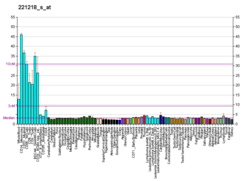TPK1
Thiamin pyrophosphokinase 1 is an enzyme that in humans is encoded by the TPK1 gene.[5][6]
This gene encodes a protein, that exists as a homodimer, which catalyzes the conversion of thiamine to thiamine pyrophosphate. Alternate transcriptional splice variants, encoding different isoforms, have been characterized.[6]
References
- 1 2 3 ENSG00000285075 GRCh38: Ensembl release 89: ENSG00000196511, ENSG00000285075 - Ensembl, May 2017
- 1 2 3 GRCm38: Ensembl release 89: ENSMUSG00000029735 - Ensembl, May 2017
- ↑ "Human PubMed Reference:".
- ↑ "Mouse PubMed Reference:".
- ↑ Nosaka K, Onozuka M, Kakazu N, Hibi S, Nishimura H, Nishino H, Abe T (May 2001). "Isolation and characterization of a human thiamine pyrophosphokinase cDNA". Biochim Biophys Acta. 1517 (2): 293–7. doi:10.1016/s0167-4781(00)00247-5. PMID 11342111.
- 1 2 "Entrez Gene: TPK1 thiamin pyrophosphokinase 1".
Further reading
- Egi Y, Koyama S, Shioda T, et al. (1992). "Identification, purification and reconstitution of thiamin metabolizing enzymes in human red blood cells". Biochim. Biophys. Acta. 1160 (2): 171–8. doi:10.1016/0167-4838(92)90004-W. PMID 1332781.
- Bohn H, Winckler W (1985). "Isolation and characterization of four new placental tissue proteins (PP18, PP19, PP20, PP21)". Arch. Gynecol. 236 (4): 235–42. doi:10.1007/BF02133941. PMID 3896163.
- Iwashima A, Kinugasa A, Nose Y (1983). "Radiometric assay for thiamine pyrophosphokinase activity in human leukocytes". Acta Vitaminol. Enzymol. 5 (1): 41–5. PMID 6303095.
- <Please add first missing authors to populate metadata.> (1999). "Toward a complete human genome sequence". Genome Res. 8 (11): 1097–108. doi:10.1101/gr.8.11.1097. PMID 9847074.
- Nosaka K, Onozuka M, Nishino H, et al. (1999). "Molecular cloning and expression of a mouse thiamin pyrophosphokinase cDNA". J. Biol. Chem. 274 (48): 34129–33. doi:10.1074/jbc.274.48.34129. PMID 10567383.
- Zhao R, Gao F, Goldman ID (2001). "Molecular cloning of human thiamin pyrophosphokinase". Biochim. Biophys. Acta. 1517 (2): 320–2. doi:10.1016/s0167-4781(00)00264-5. PMID 11342117.
- Strausberg RL, Feingold EA, Grouse LH, et al. (2003). "Generation and initial analysis of more than 15,000 full-length human and mouse cDNA sequences". Proc. Natl. Acad. Sci. U.S.A. 99 (26): 16899–903. doi:10.1073/pnas.242603899. PMC 139241. PMID 12477932.
- Scherer SW, Cheung J, MacDonald JR, et al. (2003). "Human Chromosome 7: DNA Sequence and Biology". Science. 300 (5620): 767–72. doi:10.1126/science.1083423. PMC 2882961. PMID 12690205.
- Onozuka M, Nosaka K (2004). "Steady-state kinetics and mutational studies of recombinant human thiamin pyrophosphokinase". J. Nutr. Sci. Vitaminol. 49 (3): 156–62. doi:10.3177/jnsv.49.156. PMID 12953792.
- Ota T, Suzuki Y, Nishikawa T, et al. (2004). "Complete sequencing and characterization of 21,243 full-length human cDNAs". Nat. Genet. 36 (1): 40–5. doi:10.1038/ng1285. PMID 14702039.
- Gerhard DS, Wagner L, Feingold EA, et al. (2004). "The Status, Quality, and Expansion of the NIH Full-Length cDNA Project: The Mammalian Gene Collection (MGC)". Genome Res. 14 (10B): 2121–7. doi:10.1101/gr.2596504. PMC 528928. PMID 15489334.
- Bellyei S, Szigeti A, Boronkai A, et al. (2005). "Cloning, sequencing, structural and molecular biological characterization of placental protein 20 (PP20)/human thiamin pyrophosphokinase (hTPK)". Placenta. 26 (1): 34–46. doi:10.1016/j.placenta.2004.03.008. PMID 15664409.
- Toyoshima M, Oka A, Egi Y, et al. (2005). "Thiamine-responsive congenital lactic acidosis: clinical and biochemical studies". Pediatr. Neurol. 33 (2): 98–104. doi:10.1016/j.pediatrneurol.2005.02.007. PMID 16087053.
- Onozuka M, Konno H, Akaji K, et al. (2006). "Molecular cloning and analysis of the 5'-flanking region of the human thiamin pyrophosphokinase gene". J. Nutr. Sci. Vitaminol. 51 (4): 274–7. doi:10.3177/jnsv.51.274. PMID 16262001.
- Kimura K, Wakamatsu A, Suzuki Y, et al. (2006). "Diversification of transcriptional modulation: Large-scale identification and characterization of putative alternative promoters of human genes". Genome Res. 16 (1): 55–65. doi:10.1101/gr.4039406. PMC 1356129. PMID 16344560.
- Fradin D, Bougneres P (2007). "Three common intronic variants in the maternal and fetal thiamine pyrophosphokinase gene (TPK1) are associated with birth weight". Ann. Hum. Genet. 71 (Pt 5): 578–85. doi:10.1111/j.1469-1809.2007.00348.x. PMID 17295612.
This article is issued from
Wikipedia.
The text is licensed under Creative Commons - Attribution - Sharealike.
Additional terms may apply for the media files.




